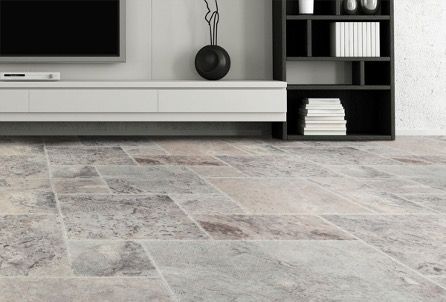Difference between travertine and limestone | which one is the best option?
Difference between travertine and limestone should be categorized into some classes. To get better information click
Travertine is good for…
Travertine – with a wide range of colors from light to dark and all kinds of patterns – has a unique property among other stones. Travertine is often unscrupulously sold by stone sellers as marble or limestone. Travertine, as a sedimentary rock and a type of limestone, is a combination of calcite that has a special softness for use in flooring. Polished travertine usually has a soft, golden, and matte appearance.
Travertine offers thermal and acoustic insulation characteristics due to its porosity, and the voids in travertine improve its fire resistance. Travertine has an acceptable strength. This stone may be carved into two shapes: one with waves and one without. When processing travertine, it contains holes and voids that must be filled. Because there are holes in the travertine, cement mortar penetrates the holes during installation, preventing the stone from collapsing. The lower specific gravity of this stone compared to some other types is significant, which may help decrease the weight of the building and the loads on its skeleton.
Travertine stone has high polishing properties, so it creates high luminosity and is also more suitable for use in volumetric designs. Travertine is utilised in Roman facades because it can produce the desired volume kinds.
But limestone is good for…
Limestone is a sedimentary rock of biological origin. Its origin dates back to the deposition of materials in earlier eras of the earth. The strong tendency of lime to combine with metals creates problems in its application in the vicinity of metals. But in the construction industry, it has many useful applications. There is a lot of knowledge about this sedimentary rock, limestone mine, and its uses, which certainly does not fit in the scope of this article.
The process of converting limestone to usable material takes place in a furnace in stages with a temperature of 900 ° C. The purpose of these steps is to evaporate and remove excess moisture and, finally, to prepare it for use in various industries. The final product of such a process is called quicklime, which is ready for use with different properties.
The most common use of lime is as one of the building materials known to the people. Lime, on the other hand, has many uses in other industries such as porcelain, food and sugar refining, cement and glass. Limestone, like travertine, is a type of porous rock and can freeze and crack in cold areas, so it must be sealed. Soft limestone is a great choice for use in busy places.

Difference between travertine and limestone
The natural beauty and durability of limestone and travertine pavers make them ideal for outdoor use. When you understand the benefits and downsides of each option, deciding which one is ideal for your outside space is simple. When it comes to choosing the right pavers for your project, consider the overall style, product cost, maintenance, and longevity.
Now let us talk about the difference between travertine and limestone one by one:
Difference between travertine and limestone: their origins
Oceans, lakes, and other bodies of water have both travertine and limestone on their floors! Travertine is formed when a certain amount of pressure is applied. Limestone, on the other hand, is formed when great heat and pressure are applied. Travertine is a relatively reasonable option to an interior or outdoor environment in terms of price. Limestone is more expensive up front, but it has a longer lifespan, making it a superior long-term investment.
Difference between travertine and limestone: Durability
Limestone and travertine are popular items, but limestone is most suitable for areas with heavy traffic. The formation pressure of travertine is lower than that of limestone, so it is naturally more brittle. It also has a tendency to chip or crack, especially at extremely hot or cold temperatures.

Difference between travertine and limestone: Color
Pavers are frequently chosen to match the colour scheme of the rest of the house. Warm yellow colour tones with fascinating vein patterns and striations are common in travertine. Limestone pavers come in a variety of hues, including beige, tan, and cream.
Difference between travertine and limestone: Cement mortar wise
Travertine tile is porous by nature, and having big pockets or gaps are common. Travertine has resin fillers applied to it to fill in the gaps and give it a smoother finish. The resin has a chance of detaching off the stone over time, especially if it is subjected to severe heat. Under-floor heating components, for example, can cause the resin to break down and separate. There are other travertine pavers without resin fillings, which are generally used only for outdoor applications.
Limestone, while still porous, lacks the wide gaps that naturally exist in travertine, obviating the need for resin fills. Limestone is a good match for under-floor heating components since it contains no fillers.
Last word
Now in Hunterpavers , you are familiar with difference between travertine and limestone in general. Consider the colours, prices, upkeep, and lifetime of each paver when choosing the appropriate one for a project. This will help you choose the paver that best fits the demands of the location.


